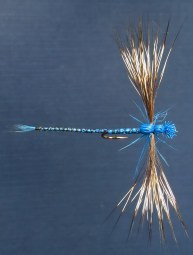Invicta Flies - Damselfly

Hook: Mustad 94831, #12
Thread: 6/0 black
Extended Body: blue deer hair
Wings: gray fox guard hairs
Legs, Back, & Head: blue deer hair
Tying Instruction:
1) Cover the front half of the shank with the tying thread. Clip a bundle of blue deer hair that is about 1/4 matchstick in diameter. Clean out any underfur and even the tips in a stacker. Measure for length (tip of tail should extend a full hook length beyond back of bend) and tie in at half shank by the butt ends. First stradle the shank with the fibers. Hold the bundle in place while you tighten the thread. The fibers should completely cover the rear half of the hook shank.
2) Still holding the deer hair bundle, slide your fingers back and lash the fibers to the shank in spriral wraps to the bend. Once at the bend, spiral the thread around the deer hair only, stopping about 1/4 inch from the tips. Take a couple extra turns of thread to secure, then spiral back to the half shank point, creating the segmented body. Clip the excess butts. Cement the securing wraps of thread near the tip of the extended body.
3) Bring the thread forward to about two and a half hook eye widths behind the eye. Clip a bundle of hair from a gray fox hide and remove the soft underfur. Stack the guard hairs in the stacker. You will have to make a judgement as far as how many fibers to use. Usually it is something less than 1/4 matchstick. Remove from the stacker and measure for length, which will equal the extended body section (from the half shank point to the tip of the tail). Tie this on top of the shank, tips forward. Divide the bundle into two equal parts and figure-eight wrap the thread to hold the division. Take four turns of thread around the far wing, then pull back with the thread to position and immediatel take two turns of thread behind to hold in place. Do the same with the near wing.
4) Prepare another bundle of blue deer hair, same size, and even the tips. Measure for length- the tips will be the legs and should be equal to the hook shank in length. Stradle the shank with the bundle, the tip below the wings and pointing out beyond the hook eye, the rest above and to the rear of the fly. Hold in place as you take a couple loose turns of thread and tighten to secure and flare the tips. Wind back tightly with the thread, lashing the remaind hairs to the sides/top of the shank all the way to the end of the extended abdomen.
5) Bring the thread forward to two thread wraps behind the wings. Pull the deer hair forward and lash down here, working the thread betwen the flared tips. This helps flare some of the tips to the rear, other to the front. Take two tight turns of thread, lift the butts, and bring the thread under the remaining deer hair over and between the wings to the far side just in front of the wings. Stroke all materials back and two or three turns of thread to anchor it in place.
6) This next part can be a little tricky. Hold the legs back out of the way while at the same time pulling the deer hair forward again between the wings. Lash this down just in front of the wings, creating a bulging thorax, with two or three tight wraps of thread.
7) Lift the butts and tie a whip finish knot around the shank only. Trim the deer hair to shape for the head, then cement the whip finish knot. Trim the leg fibers so only a few are left flaring out to the sides.